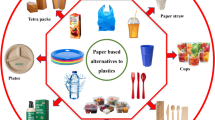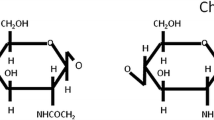Abstract
This work aims at developing an active chitosan film through the incorporation of quercetin and the evaluation of physical and functional properties of the films made thereof. The addition of quercetin showed to influence films’ properties in terms of surface morphology, tensile strength, and opacity while elongation-at-break, thickness, water vapor, and oxygen permeability were not significantly affected with incorporation of quercetin. The color parameters of chitosan films were affected by quercetin incorporation with a decrease of the values of L* and a*. The film exhibited a high free-radical scavenging activity, showing antioxidant activity. The film-forming solutions of chitosan with or without quercetin showed antibacterial activity against four Gram-negative and three Gram-positive bacteria. These results showed that quercetin incorporation in chitosan-based films has potential to be used as a solution for active food packaging.


Similar content being viewed by others
References
Aider, M. (2010). Chitosan application for active bio-based films production and potential in the food industry: review. LWT - Food Science and Technology, 43, 837–842.
ASTM D 3985–02. (2002). Standard test method for oxygen gas transmission rate through plastic film and sheeting using a coulometric sensor. In Annual book of ASTM. Philadelphia, PA: Amer. Soc. for Testing & Materials.
Azuma, K., Ippoushi, K., & Terao, J. (2010). Evaluation of tolerable levels of dietary quercetin for exerting its antioxidative effect in high cholesterol-fed rats. Food and Chemical Toxicology, 48, 1117–1122.
Badawy, M.E.I., & Rabea, E.I. (2011). A biopolymer chitosan and its derivatives as promising antimicrobial agents against plant pathogens and their applications in crop protection. International Journal of Carbohydrate Chemistry, 29p.
Bozic, M., Gorgieva, S., & Kokol, V. (2012). Homogeneous and heterogeneous methods for laccase-mediated functionalization of chitosan by tannic acid and quercetin. Carbohydrate Polymers, 89, 854–864.
Carneiro-da-Cunha, M. G., Cerqueira, M. A., Souza, B. W. S., Souza, M. P., Teixeira, J. A., & Vicente, A. A. (2009). Physical properties of edible coatings and films made with a polysaccharide from Anacardium occidentale L. Journal of Food Engineering, 95, 379–385.
Cerqueira, M. A., Lima, A. M., Teixeira, J. A., Moreira, R. A., & Vicente, A. A. (2009). Suitability of novel galactomannans as edible coatings for tropical fruits. Journal of Food Engineering, 94, 372–378.
Cerqueira, M. A., Sousa-Gallagher, M. J., Macedo, I., Rodriguez-Aguilera, R., Souza, B. W. S., Teixeira, J. A., & Vicente, A. A. (2010). Use of galactomannan edible coating application and storage temperature for prolonging shelf-life of “regional” cheese. Journal of Food Engineering, 97(1), 87–94.
Chen, C. H., & Lai, L. S. (2008). Mechanical and water vapor barrier properties of tapioca starch/decolorized hsian-tsao leaf gum films in the presence of plasticizer. Food Hydrocolloids, 22, 1584–1595.
Cushnie, T. P. T., & Lamb, A. J. (2005). Antimicrobial activity of flavonoids. International Journal of Antimicrobial Agents, 26, 343–356.
Devlieghere, F., Vermeulen, A., & Debevere, J. (2004). Chitosan: antimicrobial activity, interactions with food components and applicability as a coating on fruit and vegetables. Food Microbiology, 21, 703–714.
Dutta, P. K., Tripathi, S., Mehrotra, G. K., & Dutta, J. (2009). Perspectives for chitosan based antimicrobial films in food applications. Food Chemistry, 114, 1173–1182.
Fahlman, B. M., & Krol, E. S. (2009). UVA and UVB radiation-induced oxidation products of quercetin. Journal of Photochemistry and Photobiology B: Biology, 97, 123–131.
Gatto, M. T., Falcocchio, S., Grippa, E., Mazzanti, G., Battinelli, L., Nicolasi, G., Lambusta, D., & Saso, L. (2002). Antimicrobial and antilipase activity of quercetin and its C2-C16 3-O-acyl-esters. Bioorganic & Medicinal Chemistry, 10, 269–272.
Gramza, A., & Korczak, J. (2005). Tea constituents (Camellia sinensis L.) as antioxidants in lipid systems. Trends in Food Science & Technology, 16, 351–358.
Guirguis, O. W., Elkader, M. F. H. A., & Nasrat, A. A. (2013). Enhancing antimicrobial activity for chitosan by adding Jojoba liquid wax. Materials Letters, 93, 353–355.
Leceta, I., Guerrero, P., & Caba, K. (2013). Functional properties of chitosan-based films. Carbohydrate Polymers, 93, 339–346.
Lima, A. M., Cerqueira, M. A., Souza, B. W. S., Santos, E. C. M., Teixeira, J. A., Moreira, R. A., & Vicente, A. A. (2010). New edible coatings composed of galactomannans and collagen blends to improve the postharvest quality of fruits—influence on fruits gas transfer rate. Journal of Food Engineering, 97(1), 101–109.
Martins J. T., Cerqueira M. A., Souza B. W. S., Avides M. C., & Vicente A. A. (2010). Shelf-life extension of Ricotta cheese using coatings of galactomannans from non-conventional sources incorporating nisin against Listeria monocytogenes. Journal of Agricultural and Food Chemistry, 58, 1884–1891.
Martins, J. T., Cerqueira, M. A., & Vicente, A. A. (2012). Influence of α-tocopherol on physicochemical properties of chitosan-based films. Food Hydrocolloids, 27, 220–227.
Mishra, K., Ojha, H., & Chaudhury, N. K. (2012). Estimation of antiradical properties of antioxidants using DPPH assay: a critical review and results. Food Chemistry, 130, 1036–1043.
Mohamed, C., Clementine, K. A., Didier, M., Gérard, L., & Noëlle, D. C. M. (2013). Antimicrobial and physical properties of edible chitosan films enhanced by lactoperoxidase system. Food Hydrocolloids, 30, 576–580.
Moradi, M., Tajik, H., Rohani, S. M. R., Oromiehie, A. R., Malekinejad, H., Aliakbarlu, J., & Hadian, M. (2012). Characterization of antioxidant chitosan film incorporated with Zataria multiflora Boiss essential oil and grape seed extract. LWT - Food Science and Technology, 46, 477–484.
Norajit, K., Kim, K. M., & Ryu, G. H. (2010). Comparative studies on the characterization and antioxidant properties of biodegradable alginate films containing ginseng extract. Journal of Food Engineering, 98, 377–384.
Patel, A. R., Heussen, P. C. M., Hazekamp, J., Drost, E., & Velikov, K. P. (2012). Quercetin loaded biopolymeric colloidal particles prepared by simultaneous precipitation of quercetin with hydrophobic protein in aqueous medium. Food Chemistry, 133, 423–429.
Pereda, M., Ponce, A. G., Marcovich, N. E., Ruseckaite, R. A., & Martucci, J. F. (2011). Chitosan-gelatin composites and bi-layer films with potential antimicrobial activity. Food Hydrocolloids, 25, 1372–1381.
Pereda, M., Amica, G., & Marcovich, N. E. (2012). Development and characterization of edible chitosan/olive oil emulsion films. Carbohydrate Polymers, 87, 1318–1325.
Pinotti, A., Garcia, M. A., Martino, M. N., & Zaritzky, N. E. (2007). Study on microstructure and physical properties of composite films based on chitosan and methylcellulose. Food Hydrocolloids, 21(1), 66–72.
Portes, E., Gardrat, C., Castellan, A., & Coma, V. (2009). Environmentally friendly films based on chitosan and tetrahydrocurcuminoid derivatives exhibiting antibacterial and antioxidative properties. Carbohydrate Polymers, 76, 578–584.
Rubilar, J. F., Cruz, R. M. S., Silva, H. D., Vicente, A. A., Khmelinskii, I., & Vieira, M. C. (2013). Physico-mechanical properties of chitosan films with carvacrol and grape seed extract. Journal of Food Engineering, 115, 466–474.
Ruiz-Navajas, Y., Viuda-Martos, M., Sendra, E., Perez-Alvarez, J. A., & Fernández-López, J. (2013). In vitro antibacterial and antioxidant properties of chitosan edible films incorporated with Thymus moroderi or Thymus piperella essential oils. Food Control, 30, 386–392.
Siripatrawan, U., & Harte, B. R. (2010). Physical properties and antioxidant activity of an active film from chitosan incorporated with green tea extract. Food Hydrocolloids, 24, 770–775.
Srinivas, K., King, J. W., Howard, L. R., & Monrad, J. K. (2010). Solubility and solution thermodynamic properties of quercetin and quercetin dihydrate in subcritical water. Journal of Food Engineering, 100, 208–218.
Wang, L., Dong, Y., Men, H., Tong, J., & Zhou, J. (2013). Preparation and characterization of active films based on chitosan incorporated tea polyphenols. Food Hydrocolloids, 32, 35–41.
Wu, J., Chen, S., Ge, S., Miao, J., Li, J., & Zhang, Q. (2013). Preparation, properties and antioxidant activity of an active film from silver carp (Hypophthalmichthys molitrix) skin gelatin incorporated with green tea extract. Food Hydrocolloids, 32, 42–51.
Yu, S. H., Hsieh, H. Y., Pang, J. C., Tang, D. W., Shih, C. M., Tsai, M. L., Tsai, Y. C., & Mi, F. L. (2013). Active films from water-soluble chitosan/cellulose composites incorporating releasable caffeic acid for inhibition of lipid oxidation in fish oil emulsions. Food Hydrocolloids, 32, 9–19.
Acknowledgments
Author Marthyna Pessoa de Souza thanks the Coordenação de Aperfeiçoamento de Pessoal de Nivel Superior (CAPES/PDEE-Brazil) and Fundação de Amparo à Ciência e Tecnologia do Estado de Pernambuco (FACEPE, Brazil) for fellowships. Miguel A. Cerqueira and Hélder D. Silva (SFRH/BPD/72753/2010 and SFRH/BD/81288/2011, respectively) are recipients of a fellowship from the Fundação para a Ciência e Tecnologia (FCT, POPH-QREN and FSE Portugal). This research was financially supported by research grants and fellowships from the Conselho Nacional de Desenvolvimento Científico e Tecnológico (CNPq), as well as the Coordenação de Aperfeiçoamento de Pessoal de Nível Superior (CAPES) and Fundação de Amparo à Ciência e Tecnologia do Estado de Pernambuco (FACEPE). The authors also thank the FCT Strategic Project of UID/BIO/04469/2013 unit, the project RECI/BBB-EBI/0179/2012 (FCOMP-01-0124-FEDER-027462), and the project “BioInd - Biotechnology and Bioengineering for improved Industrial and Agro-Food processes,” REF. NORTE-07-0124-FEDER-000028 Co-funded by the Programa Operacional Regional do Norte (ON.2–O Novo Norte), QREN, FEDER
Author information
Authors and Affiliations
Corresponding authors
Rights and permissions
About this article
Cite this article
Souza, M.P., Vaz, A.F.M., Silva, H.D. et al. Development and Characterization of an Active Chitosan-Based Film Containing Quercetin. Food Bioprocess Technol 8, 2183–2191 (2015). https://doi.org/10.1007/s11947-015-1580-2
Received:
Accepted:
Published:
Issue Date:
DOI: https://doi.org/10.1007/s11947-015-1580-2




